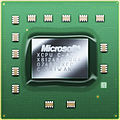 Picture of the microprocessor (XCPU-ES shown) | |
| General information | |
|---|---|
| Designed by | IBM |
| Common manufacturer | |
| Cache | |
| L1 cache | 32/32 KB |
| L2 cache | 1 MB |
| Architecture and classification | |
| Instruction set | PowerPC |
| Physical specifications | |
| Cores |
|
| POWER, PowerPC, and Power ISA architectures |
|---|
| NXP (formerly Freescale and Motorola) |
| IBM |
|
| IBM/Nintendo |
| Other |
| Related links |
| Cancelled in gray, historic in italic |
Microsoft XCPU, codenamed Xenon, is a CPU used in the Xbox 360 game console, to be used with ATI's Xenos graphics chip.
Contents
The processor was developed by Microsoft and IBM under the IBM chip program codenamed "Waternoose", which was named after the Monsters, Inc. character Henry J. Waternoose III. [1] The development program was originally announced on November 3, 2003. [2]
The processor is based on IBM PowerPC instruction set architecture. It consists of three independent processor cores on a single die. These cores are slightly modified versions of the PPE in the Cell processor used on the PlayStation 3. [3] [4] Each core has two symmetric hardware threads (SMT), for a total of six hardware threads available to games. Each individual core also includes 32 KB of L1 instruction cache and 32 KB of L1 data cache.
The XCPU processors were manufactured at IBM's East Fishkill, New York fabrication plant and Chartered Semiconductor Manufacturing (now part of GlobalFoundries) in Singapore. [5] Chartered reduced the fabrication process in 2007 to 65 nm from 90 nm, thus reducing manufacturing costs for Microsoft.




